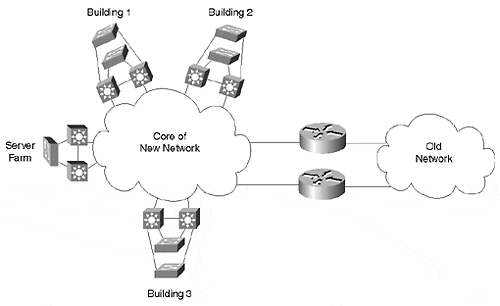Campus Migrations
It can be very challenging to manage a campus migration. New devices are brought online as older equipment is decommissioned or redeployed. However, while the rollout is taking place, connectivity must be maintained between the two portions of the network. This section makes a few high-level recommendations.
Use the Overlay Approach
During a migration, many organizations attempt to intermingle old and new equipment on the same links to form a single network. Although this does appear appealing from the perspective of trying to maintain full connectivity during the migration, it can make the rollout extremely difficult. By intermingling the two sets of equipment, the new network can be dragged down by the old equipment. Problems such as excessive bridging for non-routable protocols and Spanning Tree issues can prevent the new network from living up to its full potential. Moreover, if two Gigabit-speed switches are forced to communicate through an existing software-based router, it is like trying to drive a 6000 hp dragster down a dirt road!
In general, the most effective solution for dealing with campus migrations is to use the overlay technique.
As shown in Figure 15-14, the overlay approach treats the two networks as totally separate. Rather than connecting the new devices to the existing links, a completely out-of-band set of new links are used. If old and new devices are located in the same wiring closet, both connect to separate links. Therefore, the new network is said to overlay the existing network.
Figure 15-14. The Overlay Approach to Campus Migrations

To maintain connectivity between the old and the new network, a pair of redundant routers is used. This provides a single line where the two networks meet. Issues such as route redistribution and access lists can be easily handled here. Also notice that this causes the old network to resemble just another distribution block connected to the core of the new network (another benefit of the modularity created by the multilayer model).
EAN: N/A
Pages: 223